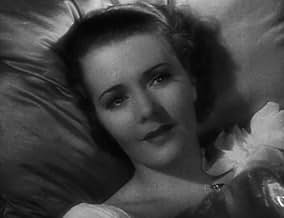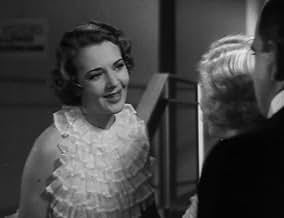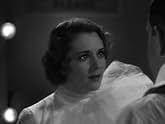Agrega una trama en tu idiomaAl Howard may be a star on Broadway, but he is no longer welcomed by any producer. It seems that he just trots off to Mexico any time he wants causing shows to close and producers to lose mo... Leer todoAl Howard may be a star on Broadway, but he is no longer welcomed by any producer. It seems that he just trots off to Mexico any time he wants causing shows to close and producers to lose money. When his sister Molly can no longer find Al work, she teams him up with talented Doro... Leer todoAl Howard may be a star on Broadway, but he is no longer welcomed by any producer. It seems that he just trots off to Mexico any time he wants causing shows to close and producers to lose money. When his sister Molly can no longer find Al work, she teams him up with talented Dorothy for a club date in Chicago. Flush with another success, Al wants to open his own club ... Leer todo
- Dirección
- Guionistas
- Elenco
- Nominado a 1 premio Óscar
- 1 premio ganado y 1 nominación en total
- Duke Hutchinson
- (as Barton Mac Lane)
- Nellie Lahey (Blonde Showgirl)
- (as Sharon Lynne)
- Tom McGee
- (as William Davidson)
- Herman Lahey
- (sin créditos)
- Wardrobe Mistress
- (sin créditos)
- Young Woman in Elevator
- (sin créditos)
- Angry Showgirl #1
- (sin créditos)
Opiniones destacadas
His sister. Molly (Glenda Farrell) finds Al in Mexico, sobers him up, and gives him the news. He doesn't take it seriously at first, but then when he can't get another job he sees the direness of the situation. His sister gets him a partner - dancer Dot Wayne (Ruby Keeler) and he is able to get a spot in a revue based on the good reputation of Dot.
But then Al decides he wants to headline once again, so he gets the financial backing for his own Broadway show. Unfortunately, the only place he can get that money is from gangster Duke Hutchinson (Barton McLane). Even more unfortunately, the Duke's wife (Helen Morgan) and Al start playing around under the Duke's nose. Meanwhile, Dot has started to fall for Al, but he thinks of her as a kid. Complications ensue.
This turned out to be better than I at first anticipated, with lots of good numbers by Jolson with the standout being "A Quarter To Nine" and subplots that include a gangster angle and even a murder mystery involving someone who is wrongfully accused. There's also a short number that may have inspired Buster Keaton a year later. In it, Al is testing Dot's assertion that she can dance to any music. He plays a highland fling, a Russian song, and other international tunes in rapid succession as she tries to keep up. Keaton did something similar in one of his best sound shorts "Grand Slam Opera" in 1936.
With Patsy Kelly as a vaudevillian who keeps popping up and who badly wants to team with Al, and with baddy Barton McLane and Glenda Farrell in their first film together but not interacting at all, this is worth your time if you appreciate the Warner musicals of the 30s. And it's not even hampered that much by the onset of the production code.
What Go Into Your Dance really was meant to do is try to save the Jolsons marriage which was in free fall by then. Al's egomania didn't make him the easiest person to live with and within a few years Keeler called it quits. For the rest of her life she would never answer one question about life with Jolson.
Warner Brothers did assemble a good cast for them. Al plays an irresponsible, egomaniacal entertainer, no stretch in the casting department. He's walked out on too many a show as his sister Glenda Farrell tells him, no producer will hire him. Never mind says Jolie, he'll produce his own with a new dancer he's discovered, Ruby Keeler.
Producing costs money and that means going to gangster Barton MacLane whose trampy wife wants to resume her show business career. Jolie gets the money and the wife played by Helen Morgan. But his problems are only beginning.
Bobby Connolly did the dance direction and I have to say pinch hit admirably for Busby Berkeley. The big hit song of the film was Jolson singing and Keeler dancing to About a Quarter to Nine. It was nicely staged and worthy of Berkeley in every sense of the word as Berkeley gave Jolson that awful Going' to Heaven on a Mule in Wonder Bar. In this film the chorus of male dancers and Jolson all turn to blackface for a minute. Jolson also does the finale title song in blackface as well.
Unfortunately not only does Jolson do blackface, but in this film, not once, but twice he rubs the head of black actor Fred "Snowflake" Toone for good luck. That particular bit of tastelessness kept Go Into Your Dance off the television screens for decades. I remember seeing it on WOR TV's million dollar movie as a lad in the Fifties, but never again until recently.
The real pity is that we were also deprived of seeing Helen Morgan sing as well. Her alcoholism had gotten pretty bad at this point, but she was one of Broadway brightest stars. She sings The Little Things You Used to Do in her typical poignant fashion. It would have really been great to see her co-star with Jolson in a film, but that was not to be.
Go Into Your Dance is quite a museum piece of a film and if you're not into Jolson, I would urge you to see it for Helen Morgan.
¿Sabías que…?
- TriviaFollowing the sensational success of Columbia's El hombre inolvidable (1946), Warner Bros. decided that Al Jolson's revived fame was a good reason to reissue this film. Although there were no changes or censor cuts, Warners did make up new opening credits, which added the famous later Warner "fanfare" and gave Jolson solo over-the-title billing. (Originally he and Ruby Keeler had both been given star billing. She was now listed in smaller print, with the rest of the supporting cast.) Additionally, the studio added a written prologue to make sure audiences knew that the story was set back in the long-ago and far-away time of 1935.
- Citas
Dorothy Wayne: Well, I finally met your brother.
Molly Howard, aka Lucille Thompson: Yeah, where is he?
Dorothy Wayne: Flat on his back, out cold, back of the Shim Sham.
Molly Howard, aka Lucille Thompson: What happened to him?
Dorothy Wayne: Well, man meets girl, girl meets husband, husband meets man, man meets sidewalk.
- Créditos curiososOpening card: Broadway..The street of ups and downs, where show business in 1935 was at top speed.
- ConexionesEdited into Musical Memories (1946)
- Bandas sonorasGo Into Your Dance
(1935) (uncredited)
Music by Harry Warren
Lyrics by Al Dubin
Played during the opening credits
Played during a rehearsal and sung by Al Jolson
Also performed by Al Jolson at the Casino De Paree at the end
Selecciones populares
- How long is Go Into Your Dance?Con tecnología de Alexa
Detalles
- Fecha de lanzamiento
- País de origen
- Idioma
- También se conoce como
- Casino de Paree
- Locaciones de filmación
- Union Station - 1050 Kettner Boulevard, San Diego, California, Estados Unidos(exterior establishing shot of the Santa Fe Depot)
- Productora
- Ver más créditos de la compañía en IMDbPro
Taquilla
- Presupuesto
- USD 703,000 (estimado)
- Tiempo de ejecución
- 1h 29min(89 min)
- Color
- Mezcla de sonido
- Relación de aspecto
- 1.37 : 1


























